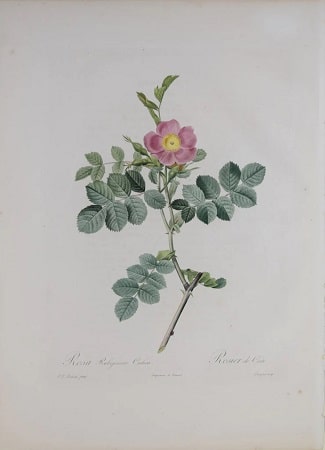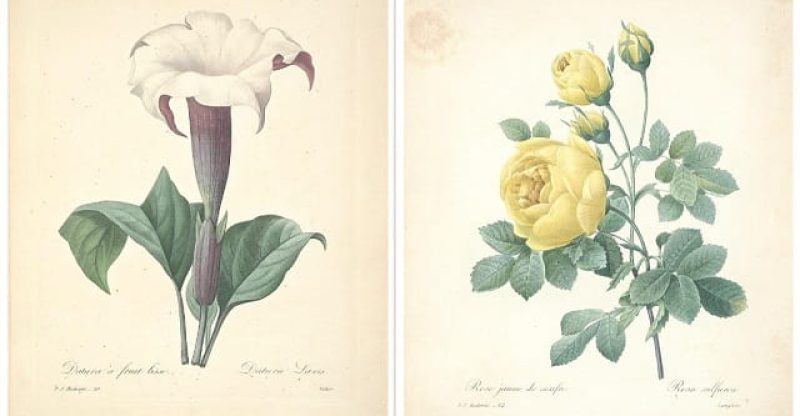Pierre-Joseph Redouté ‘s Life and Artworks
Pierre-Joseph Redouté, a maestro of botanical illustration, left an indelible mark on the art world with his exquisite renderings of flowers and plants.
Step into the enchanting world of botanical artistry with our exploration of Pierre Joseph Redoute, a legendary figure whose brushwork transformed flowers into vibrant masterpieces. Born in 1759 in the lush landscapes of Saint-Hubert, Belgium, Pierre-Joseph Redoute‘s early fascination with plants became the foundation for his extraordinary talent. His artistic journey reached new heights under the patronage of Empress Josephine, Napoleon’s wife, where he painted flowers with unparalleled detail and poetic grace.
Central to his legacy is the iconic “Les Roses” collection, where he immortalized the beauty of roses, capturing their essence and elegance. Pierre-Joseph Redouté‘s artistry went beyond the canvas; he became a storyteller, weaving scientific wonders into his illustrations.
In this post, we delve into his life, artistic brilliance, and the profound impact he made on botanical illustration, inviting you to marvel at the delicate dance between art and nature.
Pierre-Joseph Redouté’s Life, Artworks, and Botanical Masterpieces
Early Life and Passion for Botany
Born in 1759 in Saint-Hubert, Belgium, Pierre-Joseph Redouté‘s early fascination with the natural world blossomed into a lifelong passion for botany. His keen eye for detail and love for plants became evident at an early age, setting the foundation for his illustrious career as a botanical artist.

Pierre-Joseph Redouté (10 July 1759 – 19 June 1840) – Portrait by Louis Léopold Boilly.
The picturesque surroundings of his childhood became the canvas upon which his passion for plants first flourished. Fascinated by the intricate designs and vibrant hues of the local flora, young Redouté spent countless hours exploring the lush landscapes, studying the shapes of leaves, the delicate structures of flowers, and the interplay of light and shadow upon petals.
His early encounters with nature sparked a deep curiosity about the plant kingdom.
The gardens and forests of Saint-Hubert became his outdoor classrooms, where he observed, sketched, and immersed himself in the intricate details of plants. This profound connection with nature laid the foundation for his future career as a botanical artist.

Flowers by Pierre-Joseph Redouté (1759-1840) (Rosa centifolia, anemone, and clematis).
Recommended For You – Botanical Art
As he grew older, Redouté’s fascination with botany matured into a fervent passion. His keen eye for observing plants and understanding their unique characteristics set him apart even in his youth. This passion wasn’t merely about artistic expression; it was a genuine love for the botanical world, a fascination that fueled his artistic endeavors and would define his life’s work.
In this nurturing environment, Redouté’s innate talent for capturing the essence of plants began to bloom. His sketches, even in their earliest stages, displayed a remarkable level of precision and an acute awareness of botanical intricacies.

Flowers in a glass vase, 1796 by Pierre-Joseph Redouté.
This early mastery of botanical illustration laid the groundwork for his future collaborations with some of the most influential figures of his time, including Empress Josephine, who recognized and celebrated his unparalleled talent.
Pierre-Joseph Redouté’s early life and his profound connection with nature not only shaped his artistic style but also provided the inspiration for his lifework. His ability to translate the beauty of the natural world onto paper was more than a skill; it was a testament to his deep-seated passion for botany—a passion that would lead him to become one of history’s most celebrated botanical artists, leaving an enduring legacy that continues to inspire generations of artists and nature enthusiasts.
Artistic Mastery and Collaboration with Empress Josephine
Pierre-Joseph Redouté’s artistic journey reached its zenith under the patronage of Empress Josephine, the esteemed wife of Napoleon Bonaparte and a fervent lover of botanical beauty. This significant collaboration marked a pivotal moment in Redouté’s career, elevating him to the status of a celebrated artist whose work adorned the halls of royalty and the pages of history.

Joséphine de Beauharnais – Portrait by Antoine-Jean Gros, 1809.
Empress Josephine, herself an avid botanist and horticulturist, recognized Redouté’s exceptional talent and brought him into her inner circle.
Entranced by the vivid hues and intricate detailing of his botanical illustrations, she appointed him as her official court artist—a prestigious position that allowed Redouté unprecedented access to the splendors of the royal gardens.
Under the Empress’s guidance and encouragement, Redouté’s artistry flourished. His keen observational skills and ability to capture the subtlest nuances of plant life found a perfect canvas in Josephine’s extensive garden at Malmaison.
Redouté spent hours immersed in the vibrant tapestry of flowers, meticulously sketching and painting a myriad of botanical specimens.

‘Empress Josephine’ or Frankfort Rose (Rosa turbinata)(1817-1824), from Claude-Antoine Thory, Les Roses by Pierre-Joseph Redouté.
The result of this collaboration was nothing short of spectacular.
Pierre-Joseph Redouté’s works transcended mere illustrations; they became exquisite masterpieces that reflected not only the beauty of the plants but also the essence of the Empress’s passion for horticulture. His ability to infuse life into his paintings, portraying the delicate folds of petals and the play of light on leaves, mesmerized viewers and earned him admiration far beyond the confines of the royal court.
The most iconic outcome of this collaboration was the creation of the “Les Roses” series. This collection, a testament to Redouté’s exceptional skill, showcased roses in all their varieties and splendor.

Redouté Roses from “Les Roses” series by Pierre-Joseph Redouté.
Each painting was imbued with a sense of romanticism and botanical accuracy, making them timeless representations of the flower’s beauty.

Pierre-Joseph Redouté (1759-1840) – Rosa Rubiginosa Cretica From Les Roses.
Empress Josephine’s love for roses found its ultimate expression through Redouté’s brushstrokes, and the series became a cherished treasure, celebrated for its elegance and artistic finesse.
Redouté’s collaboration with Empress Josephine not only solidified his reputation as a master of botanical illustration but also left an indelible mark on the world of art and horticulture. His paintings not only adorned the walls of the imperial residence but also graced scientific publications, inspiring botanists and artists alike.
Through this partnership, Redouté’s artistry became a testament to the harmony between science and aesthetics, showcasing the intricate wonders of the natural world through the lens of artistic brilliance.
Pierre-Joseph Redouté’s Famous Artworks
Pierre Joseph Redoute, renowned as the “Raphael of Flowers,” created an extensive body of work that continues to captivate art enthusiasts and botanists alike. His meticulous attention to detail, vibrant colors, and botanical accuracy made his artworks not just illustrations but masterpieces that celebrated the exquisite beauty of nature.
1- Les Roses
One of Redouté’s most celebrated works, “Les Roses,” is a collection of paintings that immortalizes the elegance and diversity of roses.
Commissioned by Empress Josephine, this series features over 170 different species and varieties of roses, each portrayed with remarkable precision.

Damask Rose from “Les Roses” series by Pierre-Joseph Redouté.
The exquisite detailing of petals and the subtle variations in color make this collection a testament to Redouté’s artistic mastery.
2- Les Liliacées
This monumental work, commissioned by Napoleon’s wife, Empress Josephine, showcases various species of lilies.

Les liliacées, 1805-1816 by Pierre Joseph Redouté.
Pierre Joseph Redouté’s illustrations in “Les Liliacées” are characterized by their lifelike quality, depicting lilies in different stages of growth with utmost accuracy.

Amaryllis Fomossissima (Amaryllis Lys St. Jacques) by Pierre Joseph Redouté.
The collection not only serves as a botanical record but also as a testament to Redouté’s ability to capture the essence of each plant.
3- Choix des Plus Belles Fleurs
Translated as “Selection of the Most Beautiful Flowers,” this series features a wide array of flowers, including tulips, irises, and dahlias.

Choix des Plus Belles Fleurs, Plate 91 by Pierre Joseph Redouté.
Redouté’s delicate brushstrokes and meticulous rendering of botanical details make each painting in this collection a visual delight.
“Choix des Plus Belles Fleurs” showcases the artist’s versatility, portraying various flowers with equal grace and precision.
Pierre-Joseph Redouté’s famous artworks continue to inspire botanical artists and enthusiasts, serving as a testament to his extraordinary talent and deep appreciation for the natural world. His legacy lives on through these timeless creations, reminding us of the delicate balance between art and nature that he so brilliantly captured in his paintings.
References:
- https://en.wikipedia.org/wiki/Pierre-Joseph_Redout%C3%A9
- https://en.wikipedia.org/wiki/File:Pierre_Joseph_Redout%C3%A9_N08282-101-lr-1.jpg
- https://www.metmuseum.org/art/collection/search/762055
- https://en.wikipedia.org/wiki/Jos%C3%A9phine_de_Beauharnais
- https://www.audubonart.com/product-category/botanical-art/pierre-joseph-redoute/les-roses-antique-originals/
- https://digitalcollections.nypl.org/collections/les-liliaces#/?tab=about
- https://digitalcollections.nypl.org/items/510d47dd-f192-a3d9-e040-e00a18064a99
- https://en.wikipedia.org/wiki/Choix_des_plus_belles_fleurs








